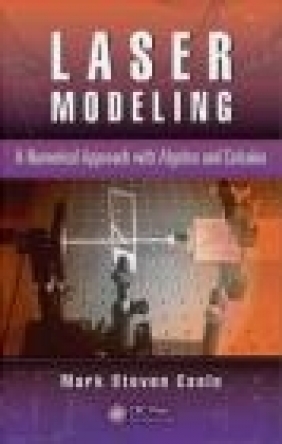Laser Modeling
Mark Steven Csele
Laser Modeling
Mark Steven Csele
- Producent: CRC Press Inc.
- Rok produkcji: 2014
- ISBN: 9781466582507
- Ilość stron: 274
- Oprawa: Twarda
Niedostępna
Opis: Laser Modeling - Mark Steven Csele
Offering a fresh take on laser engineering, Laser Modeling: A Numerical Approach with Algebra and Calculus presents algebraic models and traditional calculus-based methods in tandem to make concepts easier to digest and apply in the real world. Each technique is introduced alongside a practical, solved example based on a commercial laser. Assuming some knowledge of the nature of light, emission of radiation, and basic atomic physics, the text: Explains how to formulate an accurate gain threshold equation as well as determine small-signal gain Discusses gain saturation and introduces a novel pass-by-pass model for rapid implementation of "what if?" scenarios Outlines the calculus-based Rigrod approach in a simplified manner to aid in comprehension Considers thermal effects on solid-state lasers and other lasers with new and efficient quasi-three-level materials Demonstrates how the convolution method is used to predict the effect of temperature drift on a DPSS system Describes the technique and technology of Q-switching and provides a simple model for predicting output power Addresses non-linear optics and supplies a simple model for calculating optimal crystal length Examines common laser systems, answering basic design questions and summarizing parameters Includes downloadable Microsoft(R) Excel(t) spreadsheets, allowing models to be customized for specific lasers Don't let the mathematical rigor of solutions get in the way of understanding the concepts. Laser Modeling: A Numerical Approach with Algebra and Calculus covers laser theory in an accessible way that can be applied immediately, and numerically, to real laser systems. "One of Marc Csele's key strengths is his clear and illustrative style; he grounds the material in everyday words and examples. ...the choice and order of the chapters brings the reader along gradually from basic knowledge to practical application in a logical and comfortable way." --Marc Nantel, Niagara College, Niagara Falls, Ontario, CanadaBasic Laser Processes The Laser and Laser Light Atomic Processes of the Laser Example: Emission of Thermal Light Three- and Four-Level Schemes Example: Achieving Inversion in a Three-Level Laser Rate Equations Level Lifetime Example: Lifetime of HeNe Energy Levels Laser Gain Example: Gain in a HeNe Amplifier Losses in a Laser Cavity Optics Example: Stability of a HeNe Cavity Optical Characteristics (Longitudinal and Transverse Modes) Threshold Gain Gain and Loss: Achieving Lasing The Gain Threshold Equation Example: Threshold Gain of a HeNe Laser Example: Threshold Gain of a Non-Uniformly Pumped Ruby Laser Example: Handling Distributed Losses The Tale of Two Gains: g0 and gth Application of gth: Determining g0 Example: Determining the Gain of a HeNe Laser Example: Determining the Gain of a YAG Laser An Atomic View of Gain: Cross-Section Example: Calculating the Cross-Section of Transitions Applications of the Gain Threshold Equation: Designing Laser Optics Example: Calculating Minimum Reflectivity Example: Calculating Cavity Optic Reflectivities Example: Polarization in a HeNe Laser A Theoretical Prediction of Pumping Threshold Example: Minimum Pump Power of a YAG Laser Example: Minimum Pump Power of a Diode Laser Gain Saturation Gain is Not Constant A Third Gain Figure: Saturated Gain Saturation Intensity Example: Calculating the Saturation Power of a HeNe Transition Saturated Gain and Intra-Cavity Power Slope Efficiency Predicting Output Power Example: Predicting the Output Power of a HeNe Laser Minimum Pump Power Revisited Alternative Notations A Model for Power Development in a Laser Example: Modeling Power Buildup in a HeNe Laser Improving the Model for use with High Gain Lasers Example: Comparing Models for a Semiconductor Laser Determining Cavity Decay Parameters Example: Decay in a HeNe Laser Analytical Solutions The Rigrod Approach Example: Predicting Output Power using the Rigrod Approach Example: Application to a High Gain Laser Ring Lasers Example: A Ring Laser Example Optimal Output Coupling Example: Predicting Optimal Cavity Optics Thermal Issues Thermal Populations and Re-absorption Loss Quasi-Three-Level Systems Example: Estimating the Thermal Population of LLLs Quantum Defect Heating Example: Quantum Defect Calculations Thermal Populations at Threshold Example: Minimum Pump Power of a 946nm YAG Laser Example: Computing Fractional Populations Thermal Populations in an Operating Laser Example: Pumping a 946nm Nd:YAG Laser Thermal Effects on Laser Diodes Modeling the Effects of Temperature on Laser Diodes (Wavelength) Example: Predicting the Effect of Diode Wavelength Shift on Vanadate Thermal Effects on Laser Diodes (Power and Threshold) Example: Experimentally Determining Characteristic Temperature Low Power DPSS Design Scaling DPSS Lasers to High Powers Generating Massive Inversions: Q-Switching Inversion Buildup Q-Switch Loss Example: Minimum Loss of a Q-Switch AOM Switches Example: Bragg Angle in a Q-Switch Example: AOM Deflection EOM Switches Example: Determining the Gain of a Laser using an EOM Example: An Imperfectly-Aligned EOM Passive Q-Switches Example: A Passive Q-Switch A Model for Pulse Power Example: Output Power of a Q-Switched Laser Multiple Pulse Output Example: Predicting Q-Switch Settings for a Double-Pulse Laser Modeling Flashlamp-Pumped Lasers Example: Calculating the Time for Peak Inversion Example: Calibrating the Model Repetitively-Pulsed Q-Switched Lasers Giant First Pulse Ultrafast Lasers: Modelocking Example: Modelocking Rate and Laser Size Non-Linear Optics Origins of Non-Linear Effects Phase Matching Non-Linear Materials Practical Conversion Efficiency Applications to Laser Design Example: Intra- and Extra-Cavity Intensities Application to DPSS Design The Simple Approach The Rigrod Approach Example: A Small Green "Laser Pointer" DPSS Common Lasers and Parameters CW Gas Lasers The Helium-Neon (HeNe) Gas Laser Ion Gas Lasers The Carbon-Dioxide Gas Laser Pulsed Gas Lasers TEA CO2 Lasers Excimer Gas Lasers Semiconductor (Diode) Lasers Solid State Lasers The Ruby Laser Side-Pumped Nd:YAG Lasers End-Pumped Nd:YAG Lasers Other YAG Lasers Other Solid-State Lasers
Szczegóły: Laser Modeling - Mark Steven Csele
Tytuł: Laser Modeling
Autor: Mark Steven Csele
Producent: CRC Press Inc.
ISBN: 9781466582507
Rok produkcji: 2014
Ilość stron: 274
Oprawa: Twarda
Waga: 0.57 kg






























